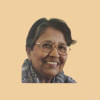Nobody’s children

Just past midnight on Manik Mia Avenue, some children were seen taking the opportunity of the traffic light turning red. While some carried flowers, others had balloons of different colours. They were seen taking these to the passengers of private cars stopped at the signal, requesting them to make a purchase.
"Sir, please take some flowers. I have to go home," a young boy of six to seven years of age, was heard saying.
This young boy named Jisan had a bunch of roses with him, which he was trying to sell to the passengers in the cars. Just then, the lights turned green again and he had to retreat, only to wait for another turn with the red lights on.
Finally, he was able to sell of his roses to this correspondent and agreed to talk to him for a few minutes.
He said he lost his father when he was five years old. His father was a CNG-run auto-rickshaw driver, who was hit by a truck. Jisan and his mother were brought to the streets to earn a living.

Jisan's mother makes flower garlands throughout the day and sells them at Dhanmondi 27 and Manik Mia Avenue. Since the restrictions of traffic police usually get relaxed after 11:00pm, Jisan starts to run after the cars to sell flowers.
He lives with her mother at a polythene-made shanty on the footpath near the Adabar truck stand area. Although he was enrolled in school, his education continued for only three months till his father's death.
Jisan is a reflection of the reality of more than seven lakh children in Dhaka. According to a Unicef study published last year, the number of street children in Bangladesh is currently 9,79,728.
By 2024, the number is expected to reach 16,15,330, according to the study.
During a recent visit to Kamalapur Rail Station, this correspondent met Shamsul from Sunamganj, who makes a living by begging at Sylhet's rail station. He came to Kamalapur four days ago and was going back to Sylhet the next day.
Sometimes he goes to other stations by train and often sleeps at the platforms. Akash and Limon had similar stories.
They got an opportunity to study at a temporary school at Kamalapur rail station run by LEEDO Bangladesh, where some 25 children are enrolled. They attend school from Monday to Thursday for two hours. The school also provides food to these children.
For the rest of the week, they have to beg to get even one meal, and mostly depend on leftover food from local restaurants.
A report published in 2016 by the Social and Economic Enhancement Program (SEEP) found that 41 percent of children living on Dhaka's streets do not have a bed to sleep in, while 44 percent are addicted to drugs, 40 percent do not take a bath daily, and 54 percent have no relatives to visit during sickness. Around 35 percent defecate in the open and 75 percent cannot seek medical advice during illness.
According to a study published by a private research institute in September last year, 79 percent of street children have been subjected to mental, physical and sexual abuse at some point in life. Around 62 percent of these disadvantaged children have been subjected to physical abuse.

This correspondent recently met two other street children, who were eating restaurant leftovers out of a polythene bag on the footpath of Farmgate at midnight, with a pile of garbage nearby. After finishing the meal, they started removing the plastic and papers from the garbage dump.
They said they both work for a city corporation cleaner, in exchange for Tk 50 each. After working till 3:00am, they usually sleep on the footpath and survive mostly on begging.
A report published in 2016 by the Social and Economic Enhancement Program (SEEP) found that 41 percent of children living on Dhaka's streets do not have a bed to sleep in, while 44 percent are addicted to drugs, 40 percent do not take a bath daily, and 54 percent have no relatives to visit during sickness.
Around 35 percent defecate in the open and 75 percent cannot seek medical advice during illness.
According to the Ministry of Social Welfare, there are currently only two drop-in centres and one emergency shelter for them.
A 2021 joint study by Consortium for Street Children, Commonwealth Foundation, LEEDO, Grambangla Unnayan Committee and Ahsania Mission also mentioned that 98.5 percent of street children are deprived of education, work an average of 10 hours a day, while 35 percent of them are involved in begging.
"A child, first of all, has the right to shelter, safety, food, and education, all of which apply to street children as well. But they are not enjoying any rights, moreover, they are falling victim to sexual and physical abuse," said Save the Children's director for Child Protection and Child Rights Governance Abdullah Al Mamun.
"These children also face economic abuse and more importantly, are involved in drugs and many other criminal activities. As a result, their overall conditions are worsening day by day," he said.
(The report is translated by Nilima Jahan)

 For all latest news, follow The Daily Star's Google News channel.
For all latest news, follow The Daily Star's Google News channel. 








Comments